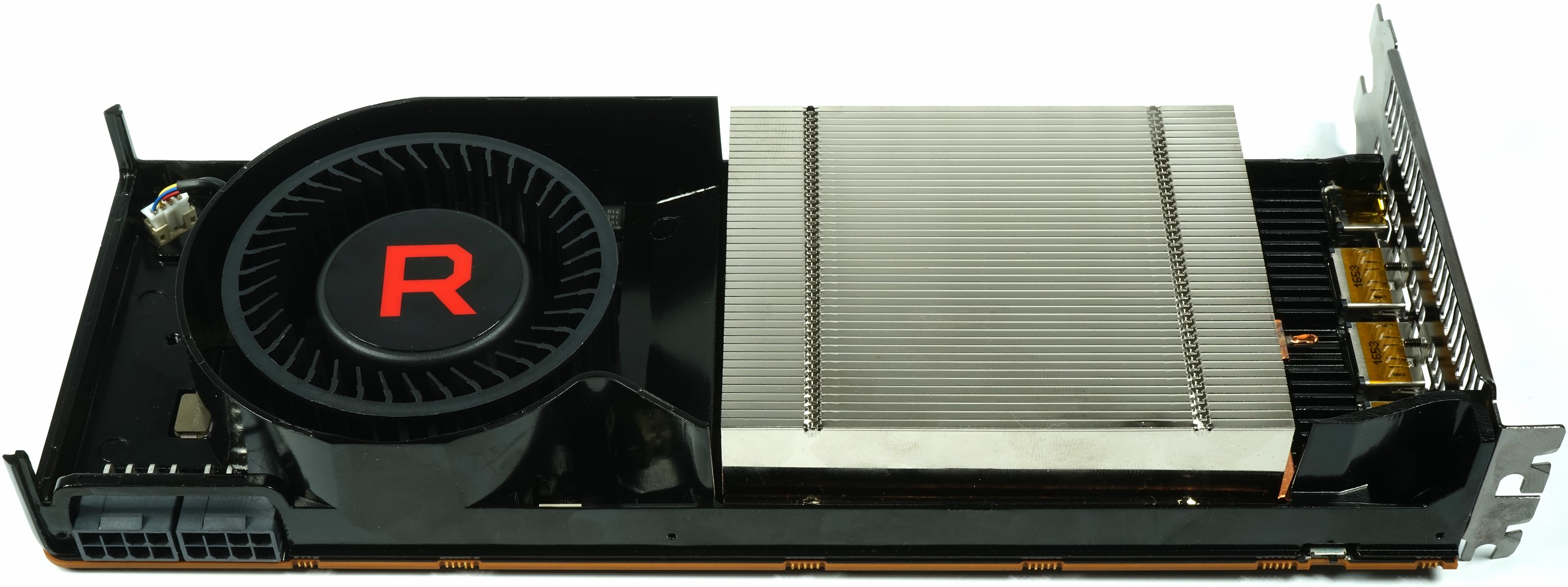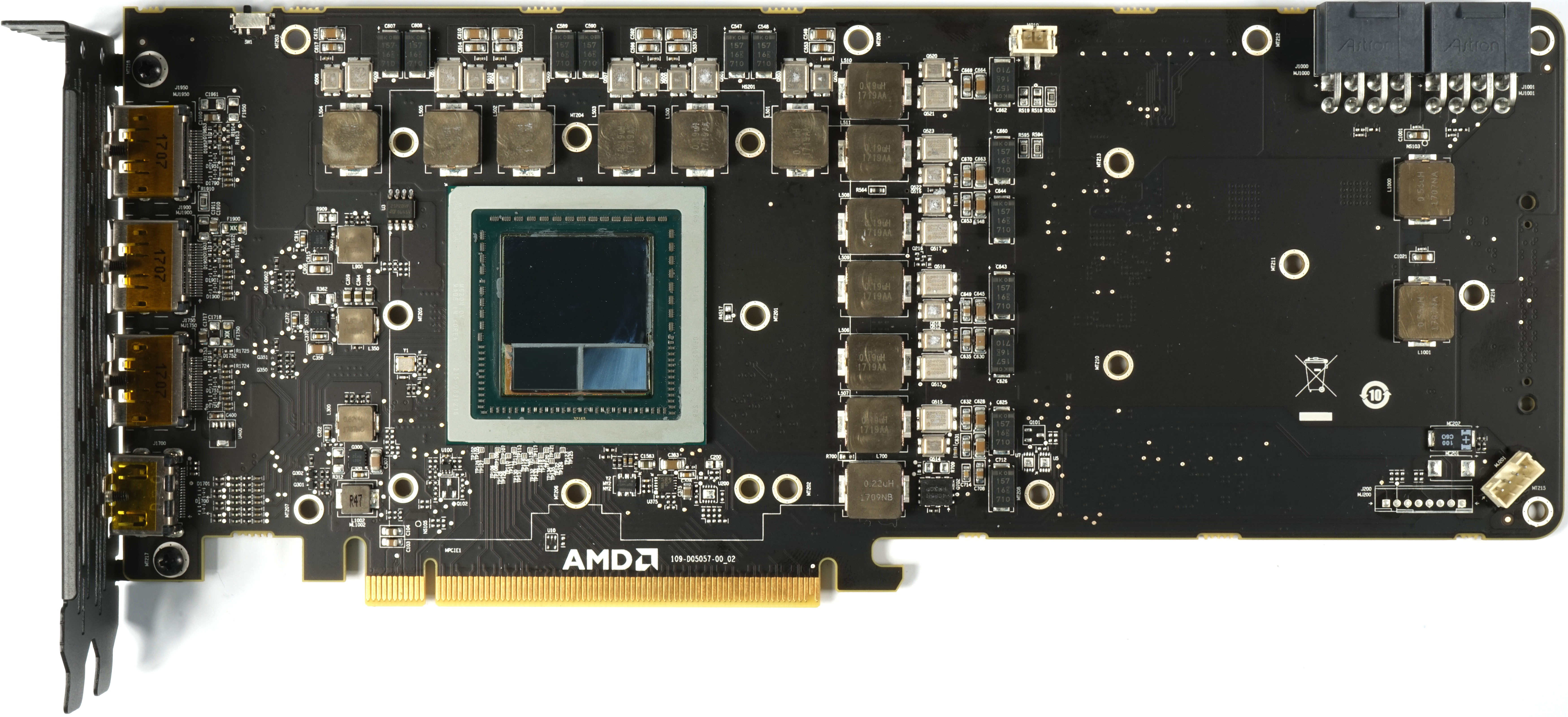AMD Radeon RX Vega 56 8GB Review
Why you can trust Tom's Hardware
Disassembly, Cooler & Interposer
Disassembly & Cooler
Some tools are needed to remove the card's cover. Six small screws that hold the shroud in place can be unfastened with a small Phillips-head screwdriver (PH1). This reveals AMD's cooler, along with a frame responsible for adding rigidity and dissipating thermal energy.
AMD leans on a direct heat exhaust solution once again, and that's not a bad thing. We can see the radial fan sitting in its chamber, which brings in air from the case. This flow passes horizontally though the sink’s body and blows out of the card’s slot cover.
The backplate is made from black anodized aluminum. Looking good is its only purpose, which is to say that the plate doesn't help with cooling. AMD secures this piece using six T6 screws.
Our attempt to make the backplate functional with thermal pads didn't get us very far; they didn't draw much waste heat away from the board.
Up top, there's a massive cooling frame that helps keep the card's structure nice and rigid. It also looks like AMD implemented some of the design lessons it learned from past generations. Similar to Gigabyte's Aorus GeForce GTX 1080 Ti Xtreme Edition, the chokes transfer heat to the frame through thermal pads. Indentations in the metal accommodate voltage regulation circuitry as well.
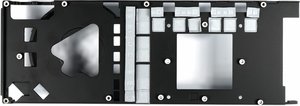

The heat sink’s body is made of thin aluminum cooling fins attached to a large copper vapor chamber. Toward the bottom of the following two pictures, you can see the chamber's outlet, which was soldered shut and should never be snapped off. A large protrusion on the copper plate's surface is situated perfectly to make contact with AMD's GPU/memory package.
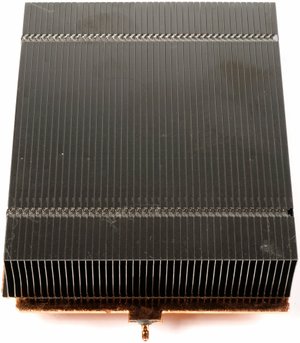
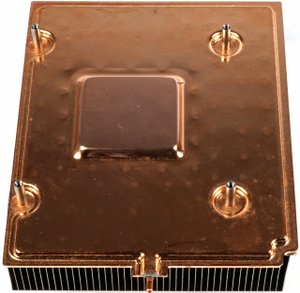
The 7cm radial fan is a simple ball bearing-based model from Delta. This is a first for AMD, and it’s certainly nice to see after generations of loud fans on the company's reference cards. Whereas those old fans spun at up to 10,000 RPM, the new BVB1012-family model hits its maximum speed at 5000 RPM. AMD’s target is around 40 to 41% duty cycle, translating to ~2000 RPM.
Get Tom's Hardware's best news and in-depth reviews, straight to your inbox.
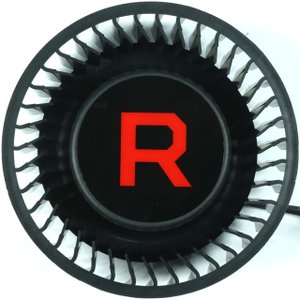
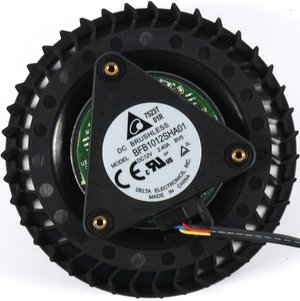
With the board completely exposed, all eyes turn to AMD's GPU and the HBM2 mounted together on an interposer, which sits on a large package substrate.
The Package: Confusion & Production Problems
Of course, the GPU can't simply be soldered to the PCB. As with AMD's Fiji-based cards, Vega and its complement of memory go through a packaging process that's handled by specialty tools. The resulting module is much easier for board partners to handle later on.
Looking at the Vega Frontier Edition and some Radeon RX Vega cards, pictured on the left, it's clear that AMD now favors the use of molding. The area around the GPU and memory is filled with an epoxy-like material that significantly improves stability. These packages are made in Taiwan and manufactured by ASE. Compare that to the version on the right, which we snapped of our Radeon RX Vega 56 sample. We went into depth on the specific differences in Is AMD Vega's Package Construction A Problem?
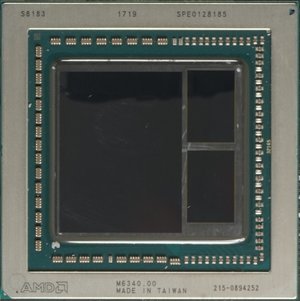
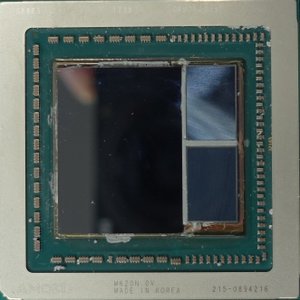
That package on the right is actually the third version we've come across; its shim, circuit board, and inscription indicate a different manufacturer and origin.
Thinking back to Fiji, AMD usually shipped its chips first to memory vendor SK hynix, which then assembled its HBM modules, had the packages completed in Korea without molding, and finally sent back, completed, to AMD. Both of the Vega cards we tested previously had molded packages from from ASE in Taiwan, so we now have a new Korean package on the scene.
So, what’s the problem? The HBM2’s positioned 40μm lower on the packages without molding and the underfill’s a bit different too. This causes unexpected production challenges, delaying add-in board partner products. We’ve been told that some of AMD’s partners are having to use six screws to attach their heat sinks instead of just four. Naturally, already-complete thermal solutions and backplates either can't be used or have to be modified to work with molding-less packages.
Is The Memory Different?
It is rumored that HBM2 made by different manufacturers (Samsung and SK hynix) is being used depending on the package version. Although we haven't talked to anyone willing to confirm this, it'd at least explain the different HBM2 module heights and the three packages we've run across. Insufficient packaging process capacity shouldn’t be a problem at this point in time, and should be excluded as the sole reason for all of this.
MORE: Best Graphics Cards
MORE: Desktop GPU Performance Hierarchy Table
MORE: All Graphics Content
Current page: Disassembly, Cooler & Interposer
Prev Page Introduction Next Page Board Layout & Components-
kjurden What a crock! I didn't realize that Tom's hardware pandered to the iNvidiot's. AMD VEGA GPU's have rightfully taken the performance crown!Reply -
Martell1977 Vega 56 vs GTX 1070, Vega goes 6-2-2 = Winner Vega!Reply
Good job AMD, hopefully next gen you can make more headway in power efficiency. But this is a good card, even beats the factory OC 1070. -
Wisecracker Thanks for the hard work and in-depth review -- any word on Vega Nano?Reply
Some 'Other Guys' (Namer Gexus?) were experimenting on under-volting and clock-boosting with interesting results. It's not like you guys don't have enough to do, already, but an Under-Volt-Off Smack Down between AMD and nVidia might be fun for readers ...
-
pavel.mateja No undervolting tests?Reply
https://translate.google.de/translate?sl=de&tl=en&js=y&prev=_t&hl=de&ie=UTF-8&u=https://www.hardwareluxx.de/index.php/artikel/hardware/grafikkarten/44084-amd-radeon-rx-vega-56-und-vega-64-im-undervolting-test.html&edit-text= -
10tacle Reply20112576 said:What a crock! I didn't realize that Tom's hardware pandered to the iNvidiot's. AMD VEGA GPU's have rightfully taken the performance crown!
Yeah Tom's Hardware does objective reviewing. If there are faults with something, they will call them out like the inferior VR performance over the 1070. This is not the National Inquirer of tech review sites like WCCTF. There are more things to consider than raw FPS performance and that's what we expect to see in an honest objective review.
Guru3D's conclusion with caveats:
"For PC gaming I can certainly recommend Radeon RX Vega 56. It is a proper and good performance level that it offers, priced right. It's a bit above average wattage compared to the competitions product in the same performance bracket. However much more decent compared to Vega 64."
Tom's conclusion with caveats:
"Even when we compare it to EVGA’s overclocked GeForce GTX 1070 SC Gaming 8GB (there are no Founders Edition cards left to buy), Vega 56 consistently matches or beats it. But until we see some of those forward-looking features exposed for gamers to enjoy, Vega 56’s success will largely depend on its price relative to GeForce GTX 1070."
^^And that's the truth. If prices of the AIB cards coming are closer to the GTX 1080, then it can't be considered a better value. This is not AMD's fault of course, but that's just the reality of the situation. You can't sugar coat it, you can't hide it, and you can't spin it. Real money is real money. We've already seen this with the RX 64 prices getting close to GTX 1080 Ti territory.
With that said, I am glad to see Nvidia get direct competition from AMD again in the high end segment since Fury even though it's a year and four months late to the party. In this case, the reference RX 56 even bests an AIB Strix GTX 1070 variant in most non-VR games. That's promising for what's going to come with their AIB variants. The question now is what's looming on the horizon in an Nvidia response with Volta. We'll find out in the coming months. -
shrapnel_indie We've seen what they can do in a factory blower configuration. Are board manufacturers allowed to take 64 and 56 and do their own designs and cooling solutions, where they can potentially coax more out of it (power usage aside)? Or are they stuck with this configuration as Fury X and Fury Nano were stuck?Reply -
10tacle No, there will be card vendors like ASUS, Gigabyte, and MSI who will have their own cooling. Here's a review of an ASUS RX 64 Strix Gaming:Reply
http://hexus.net/tech/reviews/graphics/109078-asus-radeon-rx-vega-64-strix-gaming/ -
pepar0 Reply
Will any gamers buy this card ... will any gamers GET to buy this card? Hot, hungry, noisy and expensive due to the crypto currency mining craze was not what this happy R290 owner had in mind.20112412 said:Radeon RX Vega 56 should be hitting store shelves with 3584 Stream processors and 8GB of HBM2. Should you scramble to snag yours or shop for something else?
AMD Radeon RX Vega 56 8GB Review : Read more

